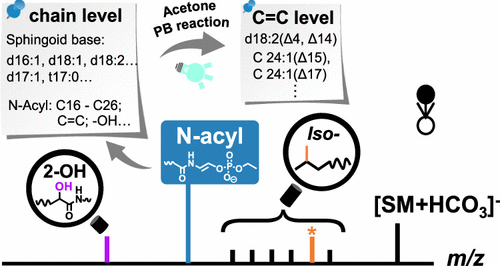Resolving Modifications on Sphingoid Base and N-Acyl Chain of Sphingomyelin Lipids in Complex Lipid Extracts
Sphingomyelins (SMs) are an essential class of lipids widely existing in different organisms. The sphingoid base and N-acyl chain are two building blocks which can undergo different types of modifications during lipogenesis, including desaturation, hydroxylation, and methyl branching. Current lipidomic analysis methods cannot provide detailed information on these structural motifs. Herein, we developed a tandem mass spectrometric method by harnessing radical-directed dissociation (RDD) from collision-induced dissociation (CID) of the bicarbonate anion adduct of SM ([M + HCO3]−). A major RDD channel produced a high-abundance fragment carrying the intact N-acyl chain, termed as “N-acyl fragment”, allowing the assignment of the sphingoid base/N-acyl composition and relative quantitation of compositional isomers of SM at high sensitivity. RDD also produced intrachain fragments in lower abundances, which helped localization of methyl branching and hydroxylation in SM. The acetone Paternò–Büchi (PB) reaction was found to be capable of derivatizing the Δ4 carbon–carbon double bond (C=C) in sphingosine (SPH) base and producing C=C diagnostic ions upon CID, albeit at much lower efficiencies than those of the isolated C=C in alkyl chains. A liquid chromatography–mass spectrometry workflow was developed by incorporating MS2 CID of SM via [M + HCO3]− and PB-MS2 CID. The capability of profiling SM with detailed structural information was demonstrated by analyzing complex lipid extracts from porcine brain and Caenorhabditis elegans. These results provided visualization of the sphingoid base/N-acyl compositional isomers of SM lipids and revealed large structural diversity from each sample. These included identification of the sphingadiene base [d18:1(Δ4,14)], C=C location isomers in N-acyls, C-2 hydroxylation of N-acyls, and iso-methyl branched SPH base.

- This study develops a tandem mass spectrometry (MS/MS) method by using radical-directed dissociation (RDD) of bicarbonate adducts to characterize sphingoid base and N-acyl composition of sphingomyelins (SMs), along with the methyl branching and hydroxylation within SMs.
- Based on this RDD method, a liquid chromatography (LC)-based workflow was established by further incorporating acetone Paternò-Büchi (PB)-MS/MS to achieve C=C localization analysis.
- The method uncovers extensive structural diversity of SMs in porcine brain and C. elegans, including C=C location isomers in N-acyls, C-2 hydroxylation of N-acyls, and iso-methyl branched sphingosine base.
Anal Chem. 2020 Nov 3;92(21):14775-14782. (IF: 6.7)


